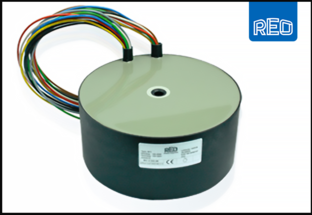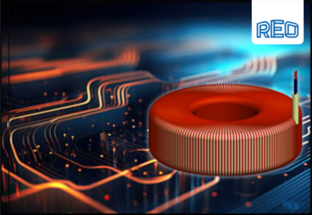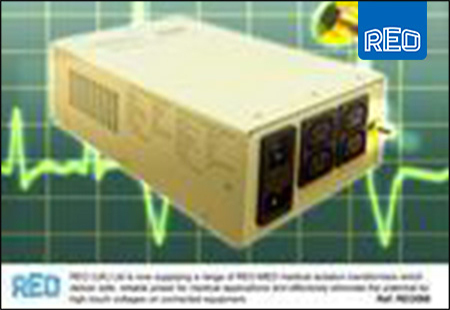What is a Toroidal Transformer?
Downloads
| toroidal_transformers.pdf ( PDF 2585KB) |
Toroidal Transformers
With their distinctive doughnut-like shape, toroidal transformers offer an efficient and versatile solution for many power supply applications. Not only do they provide enhanced design flexibility, but they also excel in terms of efficiency and compactness when compared to traditional laminated core transformers. Whether you’re in the medical, industrial, renewable energy, or audio industry, toroidal transformers are ideally suited for relatively low-KVA (up to 6 KVA) applications, although multiple cores can be connected for larger requirements.
The operation of a toroidal transformer is based on the same principles of electromagnetic induction as a conventional laminated transformer. It consists of a toroidal core, around which the primary and secondary windings are wrapped. When an electric current passes through the primary winding, it creates an electromagnetic force (EMF) that induces a current in the secondary winding. This efficient process enables power transfer from the primary coil to the secondary coil.
Volume and Weight
The toroidal transformer is designed with symmetry, ensuring that all windings are evenly distributed across the core; this shortens the winding wire’s length and allows for a higher flux density. The magnetic flux aligns with the rolling direction of the grain-orientated core, resulting in significant savings in volume and weight. Additionally, the entire surface of the toroidal core facilitates efficient cooling of the copper windings, enabling a higher current density to flow.
Toroidal Transformer Efficiency
The ideal magnetic circuit of a toroid allows it to operate at higher flux density, significantly reducing the number of wire turns needed and the core cross-sectional area. These benefits ultimately lead to reduced losses. With efficiency levels often greater than 95 percent, toroidal transformers outperform transformers made with conventional laminations, which typically offer less than 90 percent efficiency.
In today’s world, the importance of energy efficiency in electrical equipment cannot be ignored. Policymakers are now seriously considering introducing legislation that would set minimum efficiency standards for various electrical products. To meet these upcoming requirements, toroidal transformers have emerged as a reliable solution. With their superior performance and energy-saving capabilities, they are poised to play a vital role in promoting sustainability and meeting future needs.
Toroidal Transformer Audible Hum
The occurrence of audible hum in transformers is a common phenomenon. It happens when the windings and core layers vibrate, caused by the forces between coil turns and core laminations. As time passes, this hum tends to increase due to loosening laminations. However, toroidal transformers are designed to effectively reduce acoustic noise, providing a quieter operational environment essential for applications like high-end audio.
By skillfully winding the strip core made from top-tier grain-oriented silicone alloyed electric steel with minimal magnetostriction and meticulously welding and annealing it, remarkable results can be achieved in minimizing air gaps. As a result, the annoying hum that often plagues electrical devices is significantly diminished, providing a product that runs noticeably quieter.
Toroidal Transformer Magnetic Stray Field
The existence of a Magnetic Stray field beyond the equipment or component can lead to undesirable consequences, such as electromagnetic compatibility (EMC) issues. However, in toroidal transformers, this stray field is significantly reduced by approximately 85-95% compared to conventional laminated transformers. Maintaining low levels of stray fields is crucial for equipment designers as it helps prevent the occurrence of unwanted noise and interference with sensitive electronics.
Toroidal Transformer low impedance.
In addition to the low stray field, toroidal transformers can be constructed with low-impedance windings, which use more conductor cross-sectional area; this provides the connected equipment with a lower source impedance, which is often desirable in audio applications where any distortion of the mains current can lead to a noticeable degradation in audio performance.
Toroidal Transformer Magnetizing Current
Toroidal cores are renowned for their minimal iron losses, performing remarkably well even at high magnetic flux densities like 1. 7 Tesla and 50 Hz. These transformers exhibit exceptional efficiency, with iron losses typically better than 1. 4 W/kg. The reduced magnetizing current further enhances their temperature ratings, contributing to superior performance. As a result, toroidal transformers boast significantly lower ‘no-load’ power loss compared to other types of transformers, making them an excellent choice for efficient energy transfer. It is important to note that, as with all things, it is possible to demonstrate improved performance and quality through exceptional design and manufacturing; see this article for more information.
Toroidal Transformer Low Leakage Current
By using special winding techniques, toroidal transformers can be designed and manufactured to have very low leakage current levels. Leakage current flows due to unavoidable paracytic circuit elements are usually relatively low. However, it becomes essential when the toroidal transformer is used as a Medical Isolation Transformer (MIT) in a Medical Device or Medical Environment that should conform to EN60601. It is necessary in this application that Medical Isolation Transformers demonstrate leakage currents of less than 0.4 mA.
Toroidal Transformer Static Shield
When managing high-frequency line disturbances, a static screen can be beneficial. This additional winding, positioned between the primary and secondary windings, can be connected to a low-impedance system Earth. Typically made of copper foil, this screen is a shield to minimize disruptions. However, opting for highly permeable nickel-iron foil instead of copper is often helpful in meeting EMC requirements and enhancing attenuation at higher frequencies. The superior properties of this material allow for up to 20dB increase in attenuation even at lower frequencies.
Toroidal Transformer Mounting Flexibility
Compared with conventional laminated transformers, toroidal transformers can be produced to be mounted in various ways. The most straightforward is using a single bolt and two large dished washers; this is fast and reliable. Care must be taken to ensure that both ends of the fixing bolts are not grounded, as this will result in a shorted turn and damage the transformer.
Other methods include partial encapsulation, where the inner void is potted, and the fixing bolts can pass through 1 or more fixing holes; this negates the need for washers and offers a robust solution. The units can be encapsulated for applications that require a high degree of environmental protection and physical robustness; this is especially useful in applications involving shock and vibration or where the toroidal transformers mustn’t degrade over time, for example, in medical applications.













